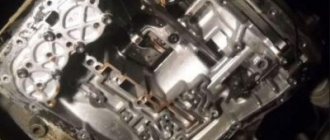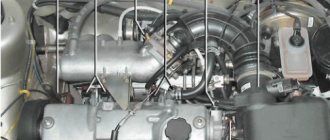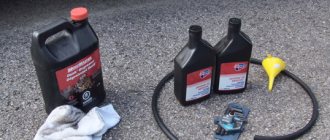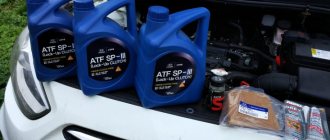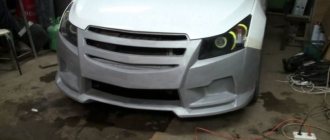When operating modern vehicles equipped with automatic transmissions, the transmission oil, as well as working units and parts of the automatic transmission, gradually become contaminated. Harmful sediments in the form of metal dust, shavings, fragments, combustion products and breakdown of friction clutches accumulate on working surfaces, filter screens, as well as in the cavities and channels of the hydraulic system. Flushing the automatic transmission is a necessary procedure to restore the stability of the transmission.
Why wash the box?
Flushing an automatic transmission before changing the oil is a rare procedure for service stations today.
The reason is not that it is expensive. It all lies in the ignorance of both car owners and service specialists. Most servicemen are not able to understand the intricacies and features of modern automatic transmissions.
In recent years, the main trend in car construction has been fuel economy, without sacrificing power and dynamics. Modern gearboxes already have 6, 8 or more steps, and shift much faster. To make the operation of the car even more economical, the torque converter has an additional clutch with partial high-frequency blocking - it improves acceleration dynamics, while the car does not consume a lot of fuel. But there are also disadvantages that are usually forgotten.
ATP liquid after 100 thousand mileage - it’s scary to imagine what kind of “mayonnaise” remains inside
The main disadvantage is the accumulation of wear products in the transmission fluid. These are small metal shavings, rubber dust, a product of the breakdown of torque converter clutches and other clutches in the box. The standard filter cleans oil from production, but not completely. A significant portion of chips and other particles circulates in the oil channels. The valves in the solenoids also wear out, since the latter are forced to work more often than on traditional 5-speed automatic transmissions. The situation is aggravated by the fact that manufacturers are switching gearboxes to oil with low viscosity - it protects parts less well from wear. And what do we see in the service book? The fluid is filled for the entire life of the car...
This box has already “arrived” at the capital
All this leads to the fact that most boxes are repaired after 60 thousand kilometers. And it doesn’t matter who the manufacturer of the automatic transmission is - the Japanese Aisin or the French AL4. But our car owners have long proven that even unsuccessful automatic transmission models can “run” 250 thousand kilometers. The secret is simple: timely maintenance and competent diagnostics.
Most service stations now do a partial replacement: drain half the waste volume and add fresh ATF in equal quantities. But there is one “but”: with such maintenance, most of the chips and dust remain inside, reducing the life of the box.
When a partial replacement does not help, car owners turn to automatic transmission flushing when changing the oil, which allows:
- reduce the likelihood of serious breakdowns of the automatic transmission;
- remove minor defects in the operation of the automatic transmission (vibrations, kicks) if they are caused by dirty channels and cavities.
Modern service – is it worth experimenting?
A huge number of service stations, as well as special oil change points, can provide any car owner with quality service with a selection of individual products. To do this, you will not need to bother with the problem of draining the used oil and the method of filling it to replace it.
Recommended: Reasons for replacing the valve cover gasket
Also, most likely, the service staff will offer to wash the engine with special detergents, but this is not necessary and only you decide whether to do this or not. Of course, all these services cost money, but the desire to save money can turn against you.
During the Soviet Union, when cars were just beginning to be widely used, there was nothing like this. Each owner, in separate garages, independently maintained and repaired his car, often using improvised means. It was from that time that the fashion of washing the engine with diesel fuel, and not only that, began. Kerosene or solvent was also used for these purposes.
Nowadays, when there are a huge number of tools specifically designed for this, using grandfather’s methods is simply illogical; why complicate life for yourself and your car. Also, one cannot be completely confident in the positive reaction of modern machines to such manipulations.
Maybe representatives of the VAZ-ZAZ era withstood various “bullies” of their owners, after which they even worked properly for some time, but today’s foreign cars, with their electronics and more advanced systems, will definitely not thank you after committing such actions.
And our grandfathers had no other choice; the quality of the same motor oil, which is used today by individual motorists for flushing, then left much to be desired, so we had to use kerosene and diesel fuel. If any foreigner knew that a similar trend is still used somewhere, he probably wouldn’t believe it. But this is true, although most drivers consider this method of cleaning the internal space of the engine to be an unjustified risk.
Thus, we came to the conclusion that in our time it is better NOT TO EXPERIMENT and trust existing technologies.
Cleaning Frequency
There have been no official studies regarding automatic transmission flushing, so it is difficult to say how often an automatic transmission should be flushed. Mechanics, based on personal experience, recommend performing the procedure before each ATP fluid replacement (that is, every 35-70 thousand kilometers).
Removed tray for washing
Sometimes it is worth performing non-scheduled flushing if there are:
- kicks when switching, which were not there before.
- jerking and jerking during acceleration;
- vibrations and other signs of unstable transmission operation.
Noise protection comes first
Many drivers are faced with the fact that certain problems arise with the gearbox as they operate.
Moreover, it does not matter which gearbox is installed - automatic or manual. Each of them requires timely, and most importantly, close attention. And the most popular problem is the noise that occurs when the transmission operates.
In most cases, additives are used as a means of reducing noise. Of course, there is an effect of their use, and in general, such tools please with their functionality. But, besides this, with the help of these compounds a number of problems are solved:
And the most popular problem is the noise that occurs when the transmission operates. In most cases, additives are used as a means of reducing noise. Of course, there is an effect of their use, and in general, such tools please with their functionality. But, besides this, with the help of these compounds a number of problems are solved:
- the operating properties of oil pumps are partially restored and their hydraulic density increases;
- surfaces with defects are partially restored;
- the service life of the gearbox increases by one and a half to two times;
- the smoothness of gear shifting is improved due to the fact that the loss of efficiency due to friction is reduced;
- noise level is reduced by up to 10 decibels;
- the elasticity of seals and other rubber-based products improves.
The use of gearbox additives to reduce noise is recommended for cars of all brands. The main thing is to understand whether the composition is suitable for a specific gear oil.
Advantages and disadvantages
Complete flushing will allow maximum removal of gear and clutch wear product from the channels and system. In addition, completely fresh oil is poured in, and not mixed with old oil, as with a partial replacement. And finally, flushing the automatic transmission, in addition to removing dirt, allows you to preserve the oil seals and seals of the valve body. This will extend the life of the hydraulic part and make the box work more adequately, without jerking and kicking.
There are no downsides if you do everything yourself. At the service station, the operation will cost a certain amount - this is the only negative.
Popular brands:
Audi S8, BMW 7-Series, Kia Rio
What's the result?
As you can see, in addition to hardware replacement and the displacement method, there are also special flushing additives for automatic transmissions or flushing oils for automatic transmissions. Some owners also use kerosene or gasoline.
In any case, after washing, you need to check the box, evaluate the quality of its operation, make sure there are no slips, jerks, etc. Finally, we note that there are, but it is not always possible and necessary to use separate rinses.
Automatic transmission repair and maintenance specialists recommend cleaning with special means only in case of urgent need, that is, avoiding additives or cleaning compounds. In other words, it is best to clean the automatic transmission with transmission oil, which is completely suitable in properties for a particular automatic transmission.
To avoid contamination of the box, it is better to change the oil in a timely manner, and also make allowances for operating conditions (the replacement is made earlier than required by regulations). This approach allows us to eliminate the risks that arise after using automatic transmission flushing oils, cleaning additives for waste, and, especially, kerosene, gasoline or diesel fuel.
Standard method
In this case, the automatic transmission will be flushed with an oil change. What to do:
- .Drain the old oil. It is advisable to warm up the box (it is enough to drive 2-3 kilometers). The oil becomes more liquid and drains much faster.
- Find the drain hole on the bottom of the crankcase and unscrew the drain plug - this is a shortened bolt with a recessed head. Wait. until the liquid stops dripping.
- Remove the automatic transmission pan. Caution: Remember that the oil is still hot. The tray should be thoroughly washed from the outside as well as from the inside. It is recommended to degrease and wipe its surface dry.
- To flush the automatic transmission, prepare a pump, hoses of sufficient length and a suitable container. Connect the hoses to the cooling system of the box, start the engine. Washing takes from ten minutes to half an hour, depending on the degree of contamination of the box.
- After cleaning is completed, replace the oil filter and crankcase gasket. The filter is most often located at the bottom (near the valve) and is easily installed after removing the crankcase. The filter is attached to different automatic transmissions in different ways - from latches to bolt-on mounts. It is better to install the gasket on the sealant.
- Reinstall the tray.
- Add fresh oil.
Filling with new ATP fluid
Important! You need to pour exactly as much oil into the box as was drained before. Remember that both underfilling and overfilling are harmful to automatic transmissions.
- Check the level on the dipstick - it should be between minimum and maximum.
- Start and warm up the engine, take a short drive;
- Check the oil level, add if necessary. Also check for any leaks around the box. If they are not there, the replacement can be considered successful.
You can work according to a different scheme. Instead of oil, regular diesel fuel is poured into the automatic transmission. Then start the engine, let it run for 10–15 minutes and drain the liquid. If clean diesel fuel comes out, stop washing. If it is dirty, then cleaning with diesel fuel continues again with a new portion being poured. But experts do not recommend using dimexide - it is very aggressive towards friction clutches.
What to wash with?
Clogged lid
Motor oils contain additives with detergent, anti-corrosion, antioxidant, and extreme pressure properties. They are not prone to the formation of deposits and dirt. Many of them are retained by the filter, and some are discharged through the crankcase drain hole. Deposits accumulate if different brands of oil are used.
That is, the remaining contaminants, mixing with the engine oil, precipitate, forming deposits. Frequent overheating of the engine leads to the formation of these, causing decomposition of the motor fluid. As a result, coke deposits that are difficult to wash off and sometimes cannot be removed appear on the inner walls of the block. The situation comes down to the rapid depletion of the lubricant life.
What's better
GZox Flushing Oil
It is preferable to use flushing fluids for the engine. Their range differs in additive components.
- FlushOil− is poured after draining the waste. It is recommended to operate the car for 50÷500 km before filling with new oil.
- EngineFlush− is used after removing the old one. Can be added to the oil in the pan. It is advisable to let the machine idle for a few minutes.
- Cleaning additives are poured into the engine 3-4 days before replacement. They have the ability to penetrate everywhere, splitting and dissolving sludge and slag.
Result of using flushing fluid
Meanwhile, there is no consensus regarding flushing oils. Doubts are raised by aggressive (alkaline) additives, which unsatisfactorily clean coked deposits of dirt within a few minutes of engine operation. And aggressive compounds lead to corrosion of rubber seals.
Advanced cleaning
Sometimes it is not possible to wash all the dirt out of the automatic transmission. So, you can use a complicated method of completely washing the automatic transmission with your own hands. But the disadvantage of this technique is the need to dismantle the unit. You need to disassemble the box and wash each element. How the work is done:
- drain the old oil from the box;
- The automatic transmission is dismantled, disassembled, and each part is washed separately using washing chemicals;
- internal channels are purged with compressed air;
- The box is put back together and fresh oil is added.
Important! When assembling the box, new seals and gaskets must be installed.
After such an operation, you need to run the car in a gentle mode for a week. Despite the difficulties associated with the need to completely disassemble the automatic transmission, this method is more effective - using it, you can completely clean the insides of the transmission from wear products.
conclusions
Carrying out the procedure every time you change the lubricant will avoid serious contamination and increase the service life of the unit. There are two ways to wash the automatic transmission yourself. The method is selected by the motorist himself separately for each case. The assembly and disassembly technology differs depending on the car model.
Do not use aggressive substances for cleaning. They can damage seals, gaskets and components. By following the sequence of actions, you will be able to clean the valve body channels yourself.
Have you washed the automatic transmission yourself without specialized equipment? Which method did you use for your car?
We save the automatic transmission with our own hands - changing the oil with running in the video:
Source
Pallet
It happens that a layer of dirt accumulates in the automatic transmission crankcase, which cannot be washed without removal. It is secured differently on different cars, but the principle is the same - unscrew the bolts along the contour. You can clean it with whatever you have at hand - gasoline, carburetor cleaning fluid and even dimexide (this is where it is safe to use). The liquid is simply poured into the crankcase, given time for the dirt to dissolve and drained. Wipe dry with a rag and put the tray in place.
Do-it-yourself crankcase cleaning
Often car owners, when washing the box themselves, use gasoline. But if the contamination is severe (and it happens that almost black oil drains from the crankcase), gasoline does not help. You can try a product from household stores - Shumanit. The product corrodes any contaminants. You can also use diesel fuel, kerosene, five-minute flush and other similar liquids as a liquid.
Flushing the hydraulic unit
Cleaning the automatic transmission valve body is not as scary as they write or talk about it. It is necessary to unscrew the valve body mounting bolts and carefully remove the part downwards. The solenoids can be cleaned using carburetor cleaner.
Cleaning the valve body
Small parts are also washed with carb cleaner. But it is better to wash the stove with gasoline, kerosene or diesel fuel - soak it overnight, rinse and dry.
Washing the automatic transmission filter
There are two types of filters for automatic transmissions:
- Reusable with fine mesh element. Such filters can be saved by washing.
- Paper or synthetic filters. They are not washed, but replaced with new ones.
The filter is usually cleaned when flushing the automatic transmission housing. You can do this yourself - the first step is to drain the old oil, remove the crankcase and dismantle the filter.
Cleaning the filter
The body of the latter may be covered in plaque or dirt. Carburetor cleaning fluid can easily remove this dirt. Once the housing is clean, you can disassemble the filter. Depending on how dirty it is, the mesh is washed with the same carb cleaner or gasoline. Wash until the mesh is visible. When its cells are clearly visible, the structure can be assembled.
How does the flushing fluid work?
When replacing the lubricant, it can be very difficult to eliminate the remaining used gearbox oil. Mixing different petroleum products is undesirable. It is necessary to remove any remaining grease by flushing the gearbox. Flushing oil neutralizes the acidic environment that forms when using the machine.
Before replacing consumables, let the engine run a little. The heated oil is quickly drained. After draining the used lubricant, pour gearbox flushing agent into the unit. Let the engine idle again. Twenty minutes will be enough to clean a manual/automatic gearbox. Drain the spent flush and add lubricant.
Is automatic transmission flushing necessary? Cleaning agents are almost never used abroad, which is why there are no products from Castrol or Shell in retail outlets. These manufacturers believe that if you follow all the maintenance rules, there will simply be no reason to flush the automatic transmission/manual transmission. You don’t have to wash the gearbox if:
- the car was just purchased at a car dealership;
- you fill the unit with high-quality lubricant;
- The oil is regularly replaced and maintenance intervals are observed.
The listed conditions are not always feasible in Russia. Cars are often purchased outside of a car dealership, and maintenance intervals are not observed. It is in such situations that the transmission is flushed.
Not so long ago, a new petroleum product appeared in Russian stores - LAVR. This consumable is used for washing manual transmissions, automatic transmissions, drive axles, and transfer elements. It has the following properties:
- there are no wear products when used in the transmission;
- increases the operational period of the gearbox;
- restores plasticity to rubber seals;
- contains antifriction additives.
Flushing the automatic transmission torque converter
It is almost impossible to do this procedure on your own. Flushing the torque converter is only possible if you cut the donut. Without opening, washing is ineffective and will not have any noticeable effect.
Opening the torque converter
If the housing is sawn, then all the elements of the torque converter immediately become accessible - you can visually assess the scale of the problem. After troubleshooting, cleaning begins. Thoroughly wash the turbine blades and elements in the clutch mechanism.
The cleaning procedure is simple - the part is immersed in a container with a high concentration cleaning solution and the carbon deposits are washed off manually. After cleaning, all dismantled elements are installed back, and the torque converter housing is welded. Next, the system is checked for leaks.
Flushing the transmission radiator
The automatic transmission gets very hot during operation, and therefore it has a cooling system with a separate heat exchanger. If the latter is not dirty, it will cope with heat removal without any problems. But as soon as a layer of dirt accumulates in the channels, the box overheats.
Cleaning the heat exchanger inside
The radiator is washed together with the gearbox before changing the oil. The most effective method is a mixture of alcohol and aqueous solvents. The service station has a washing stand for this purpose. But in a garage you can use a circulation pump yourself. How it all happens:
- remove the automatic transmission oil pipes;
- a hose coming from the pump is connected to the inlet pipe;
- the second pipe is inserted into a container suitable for washing;
- the receiving container is filled with solvent;
- The liquid is pumped into the radiator through the “return” hose (that is, it should pour out from the supply part).
- turn on the pump for up to 15 minutes.
Next, the solvent is drained. If it turns out to be very dirty, the procedure is repeated. If instead of a solvent you use a cleaning agent in aerosol cans, cleaning is carried out according to the same scheme - from supply to return. You need to pour in so much chemical until a clean solution comes out of the return part.
When washing is completed, be sure to dry the heat exchanger - this can be conveniently done with an air compressor. Next, about a liter of working fluid is poured into the automatic transmission radiator, checking it for throughput. If the liquid does not come out well, such a radiator needs to be changed - no amount of cleaning will help it.
External plaque
Important! The radiator must be clean not only inside, but also outside. We carefully wash away all the dust under low pressure of water so as not to damage the honeycombs.
Causes of oil wear
ATF transmission fluid is programmed for a certain viscosity and compression ratio. With its help, the surface of parts is cleaned of slag, metal shavings and sawdust, wear products of friction materials.
In addition, the oil in the automatic transmission protects the insides from corrosion. All these properties are retained for the period specified by the manufacturer, subject to normal use.
For information: From the point of view of the car, operation close to bench operation is considered.
That is, it is necessary to move on a flat road with a high-quality surface, without overload and frequent stops and starts. In reality, such a regime is impossible to maintain.
At city speeds, the automatic transmission overheats, metal shavings get into the ATF due to increased loads, the radiator oil lines become clogged, and the filter cannot cope with cleaning. As a result, after a certain number of kilometers, the properties of the oil are rapidly lost.
This process occurs in an arithmetic progression: when the characteristics change, the operating conditions of the automatic transmission worsen, and the reaction of converting the transmission mixture into dirty slurry develops rapidly.
